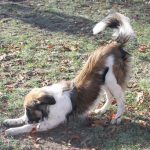Originally published Nov. 4th, 2016

Most dogs like to play. Most of a dogs play is a lighthearted version of real-life skills: chasing, catching, fetching and … fighting.
As long as it’s done in the name of good, harmless fun, there is no problem. But if it should slide beyond play: because one “combatant” feels he is losing and doesn’t want to, things can get bloody fast.
Breaking up a dog fight is dangerous, especially if there is only one Peoples. It is best to red flag it before play turns to fight.
Signs of Play

When we’re playing, the tails will be swinging happily from side to side, we may bounce side to side or enter a play bow (forelegs and chest on the ground, butt in the air), we may lunge and retreat. When happy, our eyes are open and round, ears are up, and our mouths should be open and “smiling”. We may sound like we’re about to kill each other, but as long as it’s just trash-talking we’re okay.
We may wrestle each other to the ground and pin our opponent there. We may leap around and over one another, we may body slam each other, or we may take off and run – incorporating these other moves when we get the opportunity. Biting is okay as long as it’s gentle.
When there is a group in the yard, Blondie assumes the role of Play Yard Monitor. When she’s one-on-one with another dog she is a good playmate.
Signs of Aggression
Signs that a dogs play is turning serious include squinted eyes, ears folded back, tail straight up in the air (tension, anxiety) or tucked down low (fear), and mouth kept closed except for biting. When our movements become tight and economical, we are in attack mode. We should not draw blood from our playmate, nor should she yelp in pain.
If you see any of these signs, throw a red flag immediately. Separate the players and allow them to calm down a bit before play resumes. You may need a pair of chew bones or long lasting treats to keep their attention diverted during the cool-down session.
The Rules of Play
The difference between playing and fighting (beside the intent to do bodily harm) is that there are some mutually agreed upon rules. That means if we are to be good playmates, we have to be able to agree on rules and in most cases, take turns being the “aggressor”.
Different dogs play in different ways. Some prefer a little mouth-wrestling, or tumbling around in the grass. I like to race my playmate. Some like to play-fight. This can include knocking our opponent over, pinning them down, biting their neck or legs. It can involve growling or not. Others play “patty-cake” with their paws. It is best to pair up dogs with similar play styles. If you pair a runner with a patty-caker, they will not fulfill one another’s needs and one may get insistent as he tries to force the other into his play style.
When play is effective you will see them take a mutually agreed break now and then, even if it’s just for a few seconds. They should also take turns being the “attacker” or “chaser”. Refusal on one players part to stop for a break indicates a bit too much relentlessness and should be discouraged by the play monitor.
There are exceptions, of course. We had one dog that would run for a bit then flop over on his back as soon as his pursuer was even close: he loved being the underdog. There was something wrong with that boy! But he was sweet and the others never took advantage of that trait in him.
Group Play
When dogs play in groups of three or more the volatility rises exponentially. With three, either two will gang up on one: which can shoot anxiety levels skyward for the one, or two want to play and the third tries to horn in: which can cause resentment on the part of the one being displaced.
Dogs have a tendency to “pile in” if a fight breaks out between two of their members. Six dogs playing together can suddenly become an all out war if two get into a tussle and the rest decide to join in. You’d better have a high pressure water hose on hand if that happens!
Unless your dogs are well acquainted with one another and you know their traits, try to keep them playing in matched pairs. Large groups can be fun: especially for racing, but they can also become dangerous way too fast.
By being alert for the danger signs and stepping in to calm the situation, an effective play monitor can keep the peace and allow everyone to have a great time.



